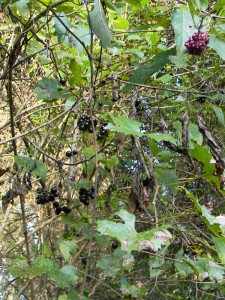The only thing better than growing and harvesting your own food…is harvesting food you didn’t have to grow!
There are some wild foods that provide you with calories but aren’t wonderfully flavored; there are others that taste great but fail to yield well; there are still others that bear prolifically and also very tasty.
Wild grapes have a bit of all three categories. They range from sweet to sour but are generally sour. Sometimes you get lucky and find vastly productive patches; other times, you find lots of vines and nary a fruit.
I once found a great grape vine while visiting relatives in a condo development in Gainesville. Unlike many grapes here, it wasn’t a muscadine, though it might have been a muscadine hybrid. The fruit was small and sweet and the plant was loaded with fruit. Unfortunately, I failed to take a photo or I’d have something to post here. I did take cuttings, however, so at least I’m propagating them. And, of course, I ate the grapes I found.
Muscadines are the most common wild grape of the south. A mess of vines run along one of our fence lines and up into the oak trees. Those vines provide us with a few gallons of free grapes almost every year. Unlike the grape vine I found in Gainesville, these grapes are larger and very tart. Our neighbors let us pick all we want of the grapes on their side as well. In return we always send them a jar of homemade jam.
The tartness of wild grapes is a good thing – it makes my wife’s homemade wild grape jam lip-smackingly good. There’s an abundance of flavor – and likely antioxidants as well – in wild grapes. (If you want to make your own, she’s posted the complete wild grape jam recipe and instructions.) Some grapes can be so sour that the acid in them will actually burn your hands and mouth. Be careful if you’re sensitive or you might have a slightly unpleasant experience. Once they’re sugared and made into jam, you’ll be fine.
Grapes usually ripen in summer and fall. If you have vines growing in your neighborhood or on your property, watch them in the spring and look for bunches of green fruit, then check them for ripeness through the year. The blooms in spring look like little bunches of tiny grapes and if you’re not experienced they’ll trick you. Many vines you encounter will be males. Their blooms simply fall off after producing pollen – and they aren’t followed by fruit. I had a gardener tell me they always had tiny grapes on their vines that never grew into anything later on. I have to break the bad news to them that unlike human males, grape males just aren’t productive.
There are ways you can try to increase the yield of wild grapes in your area. If you have vines that never produce any fruit, cut them down. If you have vines that DO produce fruit, you can prune them back in the winter or early spring to increase fruit set. You can even fertilize them if you like.
Another crazier method you might consider: grafting. Wild grapes often have very strong and extensive root systems. If you come across a non-producing male vine, you could cut it way back and graft on some female buds in the spring. I intend to experiment along these lines – and try grafting on some cultivated grape buds – this coming February just before our local grapes break dormancy.
The possibility exists for wild grapes to be made into raisins; however, most of the ones I’ve found are sour and contain seeds. I’m not sure how I’d remove the seeds for drying or if they’re worth it. When we get more grapes at once than we can process into jam, I usually just freeze them until I get a chance to use them.
Finally, before you go out eating your weight in wild grapes, make sure you don’t confuse them with their toxic cousin Virginia creeper:

Virginia Creeper berries – do NOT eat

Virginia Creeper leaves
Once you know what grape vines look like, and can spot Virginia creeper, you’re pretty safe. Just be careful when they’re growing together, which they often do when their ranges overlap.
Here’s a some shots of our local wild grapes for comparison:

Wild grape leaves – your local species may vary in looks

Wild grape fruit – your local species may vary in looks
Grape leaves are edible, however they’re astringent and many of the wild types have small leaves that aren’t big enough to do much with. Very young tender leaves are good in salads; the bigger leaves are too coarse for my taste, though I’ve eaten them steamed. Blah.
I do clip the vines and feed them to my rabbits. They don’t complain a bit; though rabbits are unable to speak. Perhaps they secretly hate them and just can’t tell me.
In addition to their edible leaves and fruit, wild grape vines are a great source for basket making materials. I’ve also used them to tie together garden trellises.
The most epic way to collect wild grapes would be in a basket made of wild grape vines; however, my baskets are ugly as sin.
That aside, go hunting for wild grapes. Once you find them, you’ll start seeing the fruit everywhere. And once you’ve had wild grape jam or jelly… you’ll never go back to store-bought grape jelly.
This article was originally published at Ready Nutrition™ on August 30th, 2014







